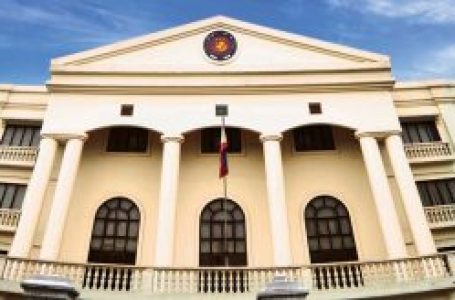When is it the Right Time to Ask for Help with your marketing?
Going way, way beyond ‘Bahay Kubo’

By Joseph L. Garcia, Senior Reporter
For a Filipino, the idea of a Filipino food buffet is rarely a reason to be excited. We have this food at home. However, a collaboration between Belmont Hotel Manila in Newport World Resorts and Lokalpedia, a one-man archivist of local ingredients, proves that Filipino food can still be exciting.
It is, however, for quite a sad reason: we actually know very little about it. It took a dinner at the hotel’s Cafe Belmont Manila on April 11 (right in the middle of Filipino Food Month) to introduce us to ingredients that in a better world, would not have needed any introductions.
Oh sure, we grew up eating sinigang, and nilaga, and kare-kare; and we grew up listening to “Bahay Kubo,” a folk song that lists vegetables — yet, John Sherwin Felix, the lone person behind Lokalpedia on Facebook and Instagram, told us, much to our surprise, that none of the 18 crops mentioned in “Bahay Kubo” are native to the archipelago. A lot of them come from the various colonial trade routes that have passed through the Philippines.
In a buffet series running through all weekends of April and May called Pamana, Mr. Felix, in partnership with Belmont Hotel Manila’s Executive Chef Andrew Ko, used indigenous ingredients to provide a taste of as close to essential as Filipino food can be.
Part of the spread included kansi, the popular Western Visayas sour soup made of beef shanks and jackfruit, and soured with the use of batwan — an endemic species of fruit bearing tree most commonly found in Western and Eastern Visayas; its leaves are used as a souring agent. Ensaladang Himbabao sa Sinamak features the indigenous vegetable himbabao: trees native to the Philippines distinct for its hanging floral spikelet. They are prominently found in Northern Luzon but rarely seen in public markets outside the region. A Kinilaw na Tuna used gamet, langkawas, and sampaguita. Gamet is a marine algae mostly found in Ilocos and Cagayan that offers an umami taste. Its harvest procedure is hazardous and seasonal as it can only be gathered during the colder season of the year when the waves are big and the winds are strong.
Etag, a sort of native preserved meat, is cured, then smoked or sun-dried by the Cordillera natives, and was used as a flavoring in many of the dishes present, including the Cordillera chicken soup pinikpikan (where the chicken is roughed up a bit to induce internal bleeding, thus making the meat tastier). Aside from that dish, our other favorite was the balbacua, a Filipino beef stew, made of assorted body parts, but especially the cow’s skin and face, cooked for several hours in various spices. In this version, Mr. Ko incorporated kalingag — native cinnamon. Paired with white rice, it made one feel like a king. We had bitter cacao tarts sweetened with balikutsa (a candy and sweetener made from sugarcane juice in Ilocos) and asin tibuok ice cream for dessert: the artisanal salt, made in an ovoid shape, is shaved over caramel ice cream, giving just a whisper of smokiness.
LOKALPEDIA
Mr. Felix hails from Occidental Mindoro, from a household that preferred slow cooking. He doesn’t have memories of his family using sinigang (sour soup) mix in the kitchen, and in fact, his mother had once scolded him for using pandan (screwpine) extract instead of pandan leaves in a recipe. He was working in PR when the pandemic changed his plans. Living in a home with good cooks, each family member tried to best each other at cooking, and Mr. Felix tried to play the game by using obscure Filipino ingredients. In his search for these ingredients, he would photograph and document them, until he decided to resign from the corporate world and do that full time.
“When I realized that I could make a change (from) this project, I resigned,” he said in English and Filipino. “During my journey, I got to discover my Filipino identity more.”
It’s not an easy life. He joked that having to go to far-off local and indigenous communities, he would have a hard time reaching out to them. “Hindi ako artista, hindi ako government (I’m not a celebrity, nor do I work for the government),” he said in a mixture of English and Filipino. “But when they see that your intentions are genuine, they will welcome you into their community.”
More than that, Mr. Felix feels deeply for the people from whom he learns about the native ingredients. As an erstwhile student activist, he said, “I know the plight of the farmers; the current system of our food landscape.”
He talked about a trip he made to Palawan. “You see the beauty of the Philippines… but you also see the other side of it.” His then-guide’s partner died of malaria a few weeks after he concluded his documentation trip in Palawan.
“Hindi sila naaabutan ng gamot, ng medical supplies… wala akong magawa (they couldn’t access medicines or medical supplies… there was nothing I could do).”
Mr. Felix points out that food is political — the course of planting crops, importation, procurement; all of the processes that bring food to the table — are influenced by movements in the political sphere. For example, a lot of the ingredients he has discovered (rather, rediscovered) are in danger of getting lost, because a lot of the producers would much rather plant, make, or do something else which is more profitable. Meanwhile, a lot of the wild and indigenous species that should be in our kitchens are becoming rarer because of deforestation, pollution, and climate change.
Frankly, with what seems to be a global-sized fist punching down, it feels like there’s not much we can do. But Mr. Felix is not giving up. “Most of the time, it’s just a knowledge gap. Biodiversity. Kahit sa backyard mo, merong makakain diyan (even in your backyard, there would be something you can eat),” he said. “You need to diversify your plate. When you diversify your plate, what gets produced also becomes more diversified,” he said in English and Filipino. By doing this, one can become an advocate of wild species and indigenous produce: “You also advocate for the rise of indigenous peoples, and the welfare of the forest,” he said.
Finally, mindful eating creates demand. In English and Filipino, he said, “What we put on our plate is what our farmers will produce.”
Not all the dishes were to our liking (mostly due to an aversion to coconut and sour tastes). For someone who thinks that way, a lot of what Mr. Felix advocates can disappear tomorrow, and a lot of people wouldn’t care. I’ve never met this nut, or this leaf, or this flower; my favorite fruits come in a can. With so much happening in the world, is everything worth saving? What do we lose when we lose a flavor, just one of many?
“We just view ingredients as ingredients,” he said in English and Filipino. “What surrounds an ingredient is the practice, the rituals, the language. The recipes; the memories.
“Hindi lang sangkap ang nawawala (not just the ingredient are lost).”
It’s a bit much for an individual to carry, and we do wish him luck. He gave us tips on what we can do to help him. But of course, there are higher powers that could make the mission to document and preserve our culinary heritage a bit easier — but more importantly, improve the lives of the people who make our food. Asked after dinner how the government can help, he said, “Tumino sila.” (“They should do better.”)
The Pamana dinner buffet will be available at Belmont Hotel Manila’s Café Belmont every Friday and Saturday of April and May from 6:30 to 9:30 p.m. for P1,450 per person. Children six to 12 years old can dine for 50% off and children five years old below eat free of charge. For reservations, call 5318-8888 or e-mail dine@belmontmanila.com. Get to know more about Lokalpedia and support its advocacy by following @lokalpediaph on Instagram and @LocalFoodHeritagePH in Facebook.














